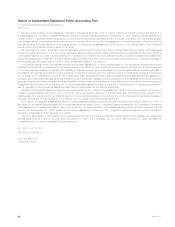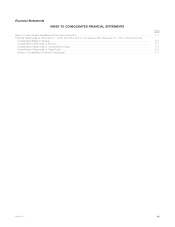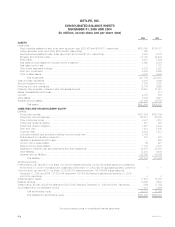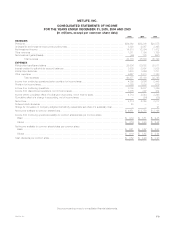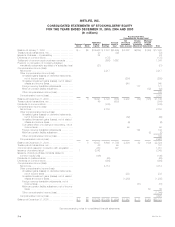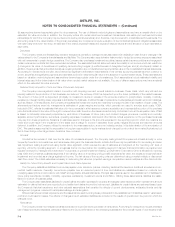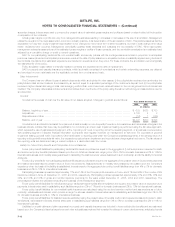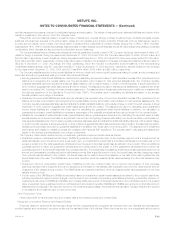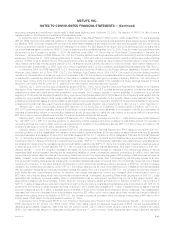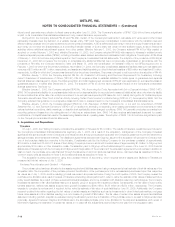MetLife 2005 Annual Report Download - page 70
Download and view the complete annual report
Please find page 70 of the 2005 MetLife annual report below. You can navigate through the pages in the report by either clicking on the pages listed below, or by using the keyword search tool below to find specific information within the annual report.METLIFE, INC.
NOTES TO CONSOLIDATED FINANCIAL STATEMENTS — (Continued)
(iii) assumptions deemed appropriate given the circumstances. The use of different methodologies and assumptions may have a material effect on the
estimated fair value amounts. In addition, the Company enters into certain structured investment transactions, real estate joint ventures and limited
partnerships for which the Company may be deemed to be the primary beneficiary and, therefore, may be required to consolidate such investments. The
accounting rules for the determination of the primary beneficiary are complex and require evaluation of the contractual rights and obligations associated
with each party involved in the entity, an estimate of the entity’s expected losses and expected residual returns and the allocation of such estimates to
each party.
Derivatives
The Company enters into freestanding derivative transactions primarily to manage the risk associated with variability in cash flows or changes in fair
values related to the Company’s financial assets and liabilities. The Company also uses derivative instruments to hedge its currency exposure associated
with net investments in certain foreign operations. The Company also purchases investment securities, issues certain insurance policies and engages in
certain reinsurance contracts that have embedded derivatives. The associated financial statement risk is the volatility in net income which can result from
(i) changes in fair value of derivatives not qualifying as accounting hedges; (ii) ineffectiveness of designated hedges; and (iii) counterparty default. In
addition, there is a risk that embedded derivatives requiring bifurcation are not identified and reported at fair value in the consolidated financial statements.
Accounting for derivatives is complex, as evidenced by significant authoritative interpretations of the primary accounting standards which continue to
evolve, as well as the significant judgments and estimates involved in determining fair value in the absence of quoted market values. These estimates are
based on valuation methodologies and assumptions deemed appropriate under the circumstances. Such assumptions include estimated volatility and
interest rates used in the determination of fair value where quoted market values are not available. The use of different assumptions may have a material
effect on the estimated fair value amounts.
Deferred Policy Acquisition Costs and Value of Business Acquired
The Company incurs significant costs in connection with acquiring new and renewal insurance business. These costs, which vary with and are
primarily related to the production of that business, are deferred. The recovery of DAC is dependent upon the future profitability of the related business.
The amount of future profit is dependent principally on investment returns in excess of the amounts credited to policyholders, mortality, morbidity,
persistency, interest crediting rates, expenses to administer the business, creditworthiness of reinsurance counterparties and certain economic variables,
such as inflation. Of these factors, the Company anticipates that investment returns are most likely to impact the rate of amortization of such costs. The
aforementioned factors enter into management’s estimates of gross margins and profits, which generally are used to amortize such costs. VOBA,
included in DAC, reflects the estimated fair value of in-force contracts in a life insurance company acquisition and represents the portion of the purchase
price that is allocated to the value of the right to receive future cash flows from the insurance and annuity contracts in force at the acquisition date. VOBA
is based on actuarially determined projections, by each block of business, of future policy and contract charges, premiums, mortality and morbidity,
separate account performance, surrenders, operating expenses, investment returns and other factors. Actual experience on the purchased business
may vary from these projections. Revisions to estimates result in changes to the amounts expensed in the reporting period in which the revisions are
made and could result in the impairment of the asset and a charge to income if estimated future gross margins and profits are less than amounts
deferred. In addition, the Company utilizes the reversion to the mean assumption, a common industry practice, in its determination of the amortization of
DAC. This practice assumes that the expectation for long-term appreciation in equity markets is not changed by minor short-term market fluctuations, but
that it does change when large interim deviations have occurred.
Goodwill
Goodwill is the excess of cost over the fair value of net assets acquired. The Company tests goodwill for impairment at least annually or more
frequently if events or circumstances, such as adverse changes in the business climate, indicate that there may be justification for conducting an interim
test. Impairment testing is performed using the fair value approach, which requires the use of estimates and judgment, at the ‘‘reporting unit’’ level. A
reporting unit is the operating segment, or a business that is one level below the operating segment if discrete financial information is prepared and
regularly reviewed by management at that level. For purposes of goodwill impairment testing, goodwill within Corporate & Other is allocated to reporting
units within the Company’s business segments. If the carrying value of a reporting unit’s goodwill exceeds its fair value, the excess is recognized as an
impairment and recorded as a charge against net income. The fair values of the reporting units are determined using a market multiple or discounted
cash flow model. The critical estimates necessary in determining fair value are projected earnings, comparative market multiples and the discount rate.
Liability for Future Policy Benefits and Unpaid Claims and Claim Expenses
The Company establishes liabilities for amounts payable under insurance policies, including traditional life insurance, traditional annuities and non-
medical health insurance. Generally, amounts are payable over an extended period of time and liabilities are established based on methods and
underlying assumptions in accordance with GAAP and applicable actuarial standards. Principal assumptions used in the establishment of liabilities for
future policy benefits are mortality, morbidity, expenses, persistency, investment returns and inflation. Utilizing these assumptions, liabilities are estab-
lished on a block of business basis.
The Company also establishes liabilities for unpaid claims and claim expenses for property and casualty claim insurance which represent the amount
estimated for claims that have been reported but not settled and claims incurred but not reported. Liabilities for unpaid claims are estimated based upon
the Company’s historical experience and other actuarial assumptions that consider the effects of current developments, anticipated trends and risk
management programs, reduced for anticipated salvage and subrogation.
Differences between actual experience and the assumptions used in pricing these policies and in the establishment of liabilities result in variances in
profit and could result in losses. The effects of changes in such estimated liabilities are included in the results of operations in the period in which the
changes occur.
Reinsurance
The Company enters into reinsurance transactions as both a provider and a purchaser of reinsurance. Accounting for reinsurance requires extensive
use of assumptions and estimates, particularly related to the future performance of the underlying business and the potential impact of counterparty credit
MetLife, Inc.
F-8



